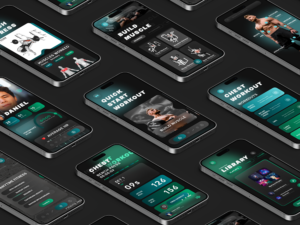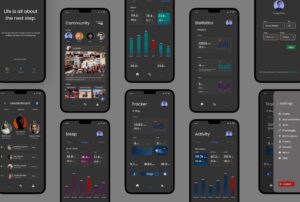A workout tracking app case study can show you how a fitness app is designed to help people stay fit and healthy. In this blog, we’ll look at a real-life example of a workout tracking app and understand how it can make a big difference in your fitness journey.
In this case study, we dive into how the app was created, the problems it aims to solve, and how it helps users track their exercises and nutrition. By examining the design and features, you’ll see how such apps can keep you motivated and on track with your fitness goals.
Introduction to Workout Tracking App Case Study
A workout tracking app case study is a detailed look into how a fitness app is designed and created. In this study, we explore how such apps help people stay fit and achieve their fitness goals. By understanding this case study, you can learn about the different features and benefits these apps offer.
In the case study, we’ll see how the app was made, from the initial ideas to the finished product. This helps us understand what goes into making a great fitness app. It also shows us why these apps are useful for tracking workouts and staying motivated.
What is a Workout Tracking App
A workout tracking app is a tool that helps you keep track of your exercise and fitness activities. These apps allow you to log your workouts, monitor your progress, and set fitness goals. They often include features for tracking calories, workouts, and other important details.
In our case study, we will explore how these apps work and what makes them effective. You will see how they help users stay on track with their fitness routines and provide useful information to reach their goals.
Why a Workout Tracking App Case Study Matters
A workout tracking app case study is important because it shows how these apps are created and how they can help users. By studying a real example, we learn about the design process and the challenges faced in developing the app. This knowledge can help in creating better apps in the future.
Understanding the case study also reveals how users interact with the app and what features they find most useful. This helps app developers improve their designs and offer better support for fitness enthusiasts.
Identifying Problems with Fitness Routines

In the workout tracking app case study, identifying problems with fitness routines is crucial. Many people struggle with finding the right exercises and staying motivated. This case study highlights these issues and how the app aims to solve them.
By understanding these problems, we can see how the app provides solutions. It offers guidance on workout routines and helps users stay on track with their fitness goals. The app also helps users avoid common mistakes and achieve better results.
Goals of a Workout Tracking App Case Study
The main goals of a workout tracking app case study are to show how the app helps users and to understand its design. One goal is to help users track their fitness activities and stay motivated. Another goal is to provide insights into how the app can be improved.
In this case study, we look at how the app meets these goals. By exploring its features and user feedback, we see how the app supports users in their fitness journey. This helps in creating apps that are more effective and user-friendly.
How Research Influences Workout Tracking Apps
Research plays a big role in designing workout tracking apps. The workout tracking app case study shows how research helps in creating features that users need. By studying exercise habits and motivations, developers can design apps that meet user needs.
In the case study, research influences the app’s design and functionality. It helps in understanding what users want and how they use the app. This leads to better features and a more effective tool for tracking fitness progress.
User Interviews in Workout Tracking App Case Study
User interviews are an important part of the workout tracking app case study. They provide valuable insights into what users need and how they use the app. Interviews help in understanding user preferences and identifying areas for improvement.
In the case study, interviews with users reveal their challenges and goals. This information guides the design process and helps create an app that meets user expectations. It also shows how the app can be tailored to different fitness needs.
Designing the Perfect Workout Tracking App
Designing the perfect workout tracking app involves creating features that users find useful. The workout tracking app case study demonstrates the design process, from sketches to high-fidelity prototypes. This process helps in developing an app that is both functional and user-friendly.
The design phase includes creating layouts, features, and interactions that enhance user experience. By focusing on what users need, the app can provide effective tools for tracking workouts and achieving fitness goals. Good design ensures that the app is easy to use and meets user expectations.
Creating User Flow for Workout Tracking Apps
Creating user flow is an essential part of the workout tracking app case study. User flow refers to how users navigate through the app and interact with its features. It helps in designing an intuitive and efficient app experience.
In the case study, user flow is designed to make it easy for users to track their workouts and progress. It includes steps like signing up, tracking activities, and viewing progress. A well-designed user flow ensures that the app is easy to use and helps users stay engaged with their fitness goals.
Sketches and Prototypes in App Design
Sketches and prototypes are important tools in the workout tracking app case study. They help in visualizing the app’s design and testing different ideas. Sketches provide initial concepts, while prototypes allow for more detailed exploration.
In the case study, sketches are used to brainstorm ideas and create basic layouts. Prototypes help in refining these ideas and testing them with users. This process helps in identifying issues and making improvements before the final design is created.
High-Fidelity Prototypes for Workout Tracking Apps
High-fidelity prototypes are detailed versions of the app design used in the workout tracking app case study. They include all the features and interactions that users will experience. These prototypes are crucial for testing and finalizing the app design.
In the case study, high-fidelity prototypes are used to ensure that the app meets user needs and expectations. They provide a realistic view of how the app will look and function. This helps in making final adjustments and ensuring a smooth user experience.
Key Features of a Successful Workout Tracking App
A successful workout tracking app includes several key features that help users achieve their fitness goals. The workout tracking app case study highlights features like progress tracking, workout recommendations, and nutritional guidance.
These features are designed to keep users motivated and provide valuable insights into their fitness journey. By including useful tools and information, the app helps users stay on track and reach their fitness goals effectively.
Tracking Your Progress with a Workout Tracking App
Tracking progress is a major feature of a workout tracking app. The workout tracking app case study shows how users can monitor their workouts and see their improvements over time. This helps in staying motivated and adjusting fitness routines as needed.
The app provides tools for logging workouts, tracking calories, and viewing progress reports. By keeping track of these details, users can see their achievements and make informed decisions about their fitness plans.
Improving User Motivation with Workout Tracking Apps
Improving user motivation is a key goal of the workout tracking app case study. The app includes features that help users stay motivated, such as progress tracking, goal setting, and workout recommendations. These features encourage users to stick with their fitness routines.
In the case study, we see how motivation is enhanced through various app features. By providing regular updates and rewards, the app helps users stay engaged and committed to their fitness goals.
Additional Features for Workout Tracking Apps
Additional features can make workout tracking apps even better. The workout tracking app case study suggests features like social sharing, leaderboards, and custom workout routines. These extras add more value and keep users engaged.
By including these features, the app offers more ways for users to interact and stay motivated. They can compare progress with friends, earn badges, and create personalized workout plans. This makes the app more fun and useful for users.
Lessons Learned from a Workout Tracking App Case Study
The workout tracking app case study provides valuable lessons about designing effective fitness apps. One key lesson is the importance of user feedback in shaping the app’s features and design. Another lesson is the need for continuous improvement based on user needs.
In the case study, these lessons help in understanding what works well and what can be improved. They guide the development process and ensure that the app meets user expectations and helps them achieve their fitness goals.
How User Feedback Shapes Workout Tracking Apps
User feedback plays a crucial role in shaping workout tracking apps. The workout tracking app case study shows how feedback from users influences the app’s design and features. This feedback helps developers make improvements and create a better user experience.
In the case study, user feedback is collected through interviews and testing. This information is used to make adjustments and enhance the app’s functionality. By listening to users, developers can create apps that better meet their needs and preferences.
Testing and Refining Workout Tracking App Designs
Testing and refining are important steps in the workout tracking app case study. They involve evaluating the app’s design and features to ensure they work as intended. Testing helps identify issues and make necessary improvements before the app is released.
In the case study, testing includes using prototypes and gathering user feedback. This process helps in refining the app and addressing any problems. It ensures that the final product is user-friendly and meets the goals of the project.
Future of Workout Tracking Apps
The future of workout tracking apps is bright and full of possibilities. The workout tracking app case study gives us a glimpse into upcoming trends and innovations. Future apps may include more advanced features and integrations with other health technologies.
As technology evolves, workout tracking apps will continue to improve. They may offer new ways to track fitness, provide personalized recommendations, and enhance user motivation. The future holds exciting opportunities for making fitness apps even more effective and engaging.
Why You Should Use Insights from a Workout Tracking App Case Study
Using insights from a workout tracking app case study can help you understand how to create better fitness apps. These insights provide valuable information about user needs, design processes, and feature effectiveness. By applying these lessons, you can develop apps that are more useful and engaging.
In the case study, we see how real-world examples can guide the development of fitness apps. By learning from these insights, you can create apps that help users achieve their fitness goals and stay motivated.
Understanding the Design Process in a Workout Tracking App Case Study
The design process in a workout tracking app case study involves several steps to create a user-friendly app. Initially, designers sketch out ideas to visualize the app’s layout. These sketches help in brainstorming and refining the app’s appearance and functionality.
Once sketches are complete, designers create low-fidelity prototypes. These are basic versions of the app that help test and improve design ideas. By iterating on these prototypes, designers ensure that the final app is both functional and appealing to users.
How User Goals Influence Workout Tracking App Design
User goals significantly influence the design of a workout tracking app. The workout tracking app case study highlights how understanding what users want helps in creating useful features. For example, if users aim to lose weight, the app might include tools for tracking calorie intake and exercise routines.
Designers use insights from user goals to prioritize features that meet these needs. This approach ensures that the app supports users in achieving their fitness objectives and remains relevant to their personal goals.
Key Challenges in Developing a Workout Tracking App
Developing a workout tracking app comes with various challenges. The workout tracking app case study outlines some common issues, such as ensuring the app’s accuracy and keeping users engaged. One challenge is integrating features that track different types of workouts and nutritional data.
Another challenge is designing an intuitive user interface. The app needs to be easy to navigate so users can quickly access the information they need. Addressing these challenges is crucial for creating an effective and user-friendly fitness app.
Importance of User Testing in Workout Tracking App Case Study
User testing is a critical part of the workout tracking app case study. It involves getting feedback from real users to see how well the app works in practice. Testing helps identify usability issues and areas for improvement before the app is launched.
In the case study, user testing provides valuable insights into how users interact with the app. It helps developers make necessary adjustments and ensure that the app meets user expectations. This process is essential for creating a successful and functional app.
Analyzing Data from Workout Tracking Apps

Analyzing data from workout tracking apps helps in understanding user behavior and app performance. The workout tracking app case study shows how data can be used to improve the app’s features and user experience. For instance, tracking user progress helps in identifying popular features and areas needing enhancement.
By analyzing this data, developers can make informed decisions about updates and new features. This analysis ensures that the app continues to meet user needs and stays relevant in the competitive fitness app market.
Benefits of Integrating Social Features in Workout Tracking Apps
Integrating social features into workout tracking apps can enhance user engagement and motivation. The workout tracking app case study suggests adding features like leaderboards and social sharing to make the app more interactive. These features allow users to compare their progress with friends and share achievements.
Social features also help in building a community of users who support each other’s fitness goals. This sense of community can increase motivation and make the app more enjoyable to use.
Customization Options in Workout Tracking Apps
Customization options are important for making workout tracking apps more user-friendly. The workout tracking app case study highlights how allowing users to create personalized workout plans and set specific goals can improve the app’s effectiveness.
Customization lets users tailor the app to their unique fitness needs and preferences. This flexibility helps in keeping users engaged and ensures that the app provides relevant and useful information for their fitness journey.
Conclusion
The workout tracking app case study shows how important it is to understand what users need and want. By talking to real people and testing different ideas, we learned how to create an app that helps people stay motivated and reach their fitness goals. This process helps in designing an app that is not only useful but also fun to use.
In the end, the case study highlights that making a good fitness app is about more than just tracking workouts. It’s about making sure the app fits the user’s needs and makes them want to keep using it. By focusing on what users want and testing ideas, we can create an app that truly supports their fitness journey.







